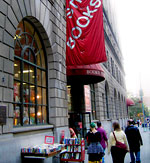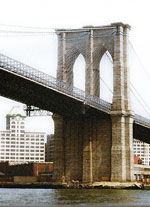The Writing Life
The ghosts of hundreds of writers and artists call Greenwich Village home.
But the passage of time has had a less disastrous affect on the basement-level piano bar Marie’s Crisis on Grove Street and 7th Avenue South. Though you’d never know it from the jovial crowd around the piano belting out songs from Gypsy, West Side Story, or A Chorus Line, Thomas Paine died upstairs giving this genuine dive landmark status. Many years later, Marie’s first owner named the bar after herself and Paine’s 1776 pamphlet, The Crisis. (Look for the plaque commemorating Paine outside the front door.) Though bar-goers are encyclopedias when it comes to Broadway, the atmosphere is light as a feather. A friend of mine has managed to gain notoriety for clucking melodies like a chicken when he doesn’t know the lyrics.
While landmarks are well and good, they do have a way of reminding us of who’s gone and what’s changed. If we’re talking about local businesses, especially independently owned bookstores, change is usually not a good thing. New York City lost Coliseum Books and Gotham Book Mart in 2007. The Oscar Wilde Bookshop, on Mercer Street in Greenwich Village, the country’s oldest gay and lesbian bookstore, shut its doors in March, but in addition to the seemingly-invincible Strand Bookstore, neighborhood shops with deliberate selections still persevere. Three Lives, a self-described “haven for people who read,” on West 10th Street and Waverly Place, isn’t just a bookstore, it’s a cherished West Village refuge. The website boasts a glowing review from The Hours’ author Michael Cunningham, who says, “I go there when I’m feeling depressed and discouraged, and I always feel rejuvenated.” And it does deliver on celebrity-author sightings. On a recent Saturday, I acted engrossed in a signed copy of David Markson’s Springer’s Progress while eavesdropping as the writer himself narrated recent bad dreams to a pair of rapt 30-somethings.
Edna St. Vincent Millay would have to give up poetry for copywriting to afford today’s rent.
About 10 blocks north of Three Lives, at the Cavin-Morris gallery in Chelsea (210 11th Avenue, Suite 201), the books on display are a bit harder to read. Here Japanese avant-garde ceramicist Yohei Nishimura’s first solo exhibit in New York City is on display until April 25. However, instead of ceramics, this time Nishimura has cooked books in his 1000-degree ovens. It strikes the book fetishist in me as a bit controversial, but I’ve got to acknowledge that the burning extends and transforms the life of droll texts such as an early edition of The Norton Anthology of American Literature, as well as racier volumes like From Playboy, Sex American Style. These brittle brown, yellow, and white clusters of burnt print and binding retain their essence despite complete transformation. Themes of art, endurance, and malleability will seem explicit to anyone who has spent the day browsing rare print materials, but, resembling pillows of tissue or barnacled seashells, the objects lend themselves to endless interpretation.
A short walk away from Cavin-Morris to Printed Matter (10th Avenue and 22nd Street), I find literature that’s more intact. Inside is an unparalleled collection of artists’ books. Not folios, monographs or catalogue raisonnés, but books by artists like Vito Acconci, Richard Prince—a devoted rare books collector himself—Ed Ruscha, and Rosemarie Trockel. I get lost in the wellspring of future rare editions and collectables that are usually printed in small runs. Inside the shop the atmosphere is comfy, but stark; like the typical Chelsea gallery space, it’s the art—in this case many-colored, sometimes playful and often beautifully designed—that brings the shop to life.
Energized, I head for the “giant obelisk-like towers” of Walt Whitman’s Brooklyn Bridge that will lead me home. You didn’t think a freelancer could afford to actually live in the Village, did you?









